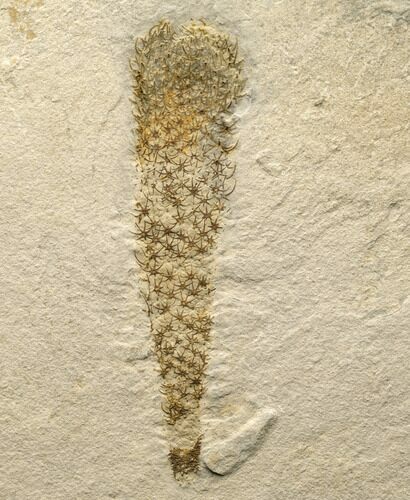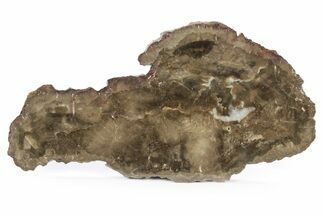This Specimen has been sold.
Rare, Enigmatic Chancelloria Pentacta - Utah
This is another exceptional offering from the high end collection of material primarily acquired back in the 1980's and 1990's which is being sold on FossilEra.com The specimens from this collection represent some of the highest quality examples of their types found.
Chancelloria is a type of early and controversial animal, known initially from the Middle Cambrian Burgess Shale and, more recently, the Marjum Formation of western Utah. They were first described in 1910 by famous paleontologist, Charles Doolittle Walcott, who regarded them as the most primitive group of sponges. Walcott found very few of them during several summer expeditions to the Canadian Rocky Mountains. Throughout the Walcott quaries, Chancelloria eros was a very rare fossil and accounts for just 0.34% of the total Burgess Shale community collected.
NOTE: All Burgess Shale fossils are protected by the Canadian government, listed as a UNESCO world heritage site and are only collected by approved researchers. They cannot be legally collected or sold.
Every bit as rare as any Burgess shale material, this large, perfect specimen of Chancelloria pentacta comes from a private “red bed” lease (Wheeler Shale - Marjum Formation) in the House Range in Utah, where the ubiquitous trilobite, Elrathia kingii, is found, every year, by the thousands.
There’s even a slightly weathered Elrathia trilobite on the backside of this thick plate. Although just a few Chancelloria pentacta were unearthed in one small pocket well over a decade ago, it is legal to own these amazing fossils from the Cambrian explosion... if one could be located. This particular specimen probably one of the best ever collected. It is a large, perfectly centered specimen with fabulous detail, and wonderful “red bed” coloration.
Classifying the chancelloriids has been controversial. Chancelloriids had bag-like bodies with an orifice at the top, and show no evidence of internal organs. Some paleontologists classify them as a type of primitive glass sponge... an idea based on chancelloriids' sessile lifestyle and simple structure. However, detailed study of the limited fossil evidence suggests otherwise. Researchers argue that they were clearly more advanced, or at least originated from more advanced ancestors.
The unique star shaped “spicules” of Chancelloria are much more complex than those on any sponge. These structures are amazingly well preserved on this specimen.
True (calcareous) sponges have solid spicules, but the unique “rays” of Chancelloria are hollow - with a microscopic pore at each base. It has been suggested that chancelloriids were related to the scleritome bearing animals, like the slug-like halkieriids, which are important (and unusual) faunal components of the Cambrian explosion.
To date, Chancelloria sp. remain rare and enigmatic organisms of uncertain ancestry.
Chancelloria is a type of early and controversial animal, known initially from the Middle Cambrian Burgess Shale and, more recently, the Marjum Formation of western Utah. They were first described in 1910 by famous paleontologist, Charles Doolittle Walcott, who regarded them as the most primitive group of sponges. Walcott found very few of them during several summer expeditions to the Canadian Rocky Mountains. Throughout the Walcott quaries, Chancelloria eros was a very rare fossil and accounts for just 0.34% of the total Burgess Shale community collected.
NOTE: All Burgess Shale fossils are protected by the Canadian government, listed as a UNESCO world heritage site and are only collected by approved researchers. They cannot be legally collected or sold.
Every bit as rare as any Burgess shale material, this large, perfect specimen of Chancelloria pentacta comes from a private “red bed” lease (Wheeler Shale - Marjum Formation) in the House Range in Utah, where the ubiquitous trilobite, Elrathia kingii, is found, every year, by the thousands.
There’s even a slightly weathered Elrathia trilobite on the backside of this thick plate. Although just a few Chancelloria pentacta were unearthed in one small pocket well over a decade ago, it is legal to own these amazing fossils from the Cambrian explosion... if one could be located. This particular specimen probably one of the best ever collected. It is a large, perfectly centered specimen with fabulous detail, and wonderful “red bed” coloration.
Classifying the chancelloriids has been controversial. Chancelloriids had bag-like bodies with an orifice at the top, and show no evidence of internal organs. Some paleontologists classify them as a type of primitive glass sponge... an idea based on chancelloriids' sessile lifestyle and simple structure. However, detailed study of the limited fossil evidence suggests otherwise. Researchers argue that they were clearly more advanced, or at least originated from more advanced ancestors.
The unique star shaped “spicules” of Chancelloria are much more complex than those on any sponge. These structures are amazingly well preserved on this specimen.
True (calcareous) sponges have solid spicules, but the unique “rays” of Chancelloria are hollow - with a microscopic pore at each base. It has been suggested that chancelloriids were related to the scleritome bearing animals, like the slug-like halkieriids, which are important (and unusual) faunal components of the Cambrian explosion.
To date, Chancelloria sp. remain rare and enigmatic organisms of uncertain ancestry.
SPECIES
Chancelloria pentacta
AGE
LOCATION
House Range, Near Delta, Utah
FORMATION
Wheeler Formation
SIZE
3" on 5x6" matrix
CATEGORY
ITEM
#14832
We guarantee the authenticity of all of our specimens.
 Reviews
Reviews














